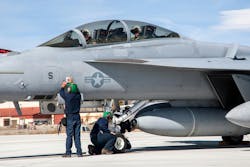Navy asks Lockheed Martin for electro-optics parts to provide passive search and track for combat aircraft
Questions and answers:
- What is the primary advantage of the IRST Block II system on the F/A-18E/F Super Hornet? It enables the aircraft to detect, track, and target enemy aircraft passively—without using radar—making it harder for adversaries to detect the Super Hornet.
- What components are included in the $233 million contract awarded to Lockheed Martin? The contract includes 59 infrared receivers, 20 inertial measurement units, and 45 processors for the Navy and Air National Guard.
- How does the IRST system detect targets without revealing its own position? It uses passive infrared sensors to detect the heat signatures of targets, rather than emitting radar signals, making it immune to electronic jamming and stealthy in operation.
PATUXENT RIVER NAS, Md. – U.S. Navy air combat experts are asking electro-optics engineers at Lockheed Martin Corp. to build components for infrared search and track (IRST) sensors on the F/A-18E/F Super Hornet jet fighter-bomber to enable the aircraft to detect, track, and attack enemy aircraft in a stealthy way without making its presence known.
Officials of the Naval Air Systems Command at Patuxent River Naval Air Station, Md., announced a $233 million contract last week to the Lockheed Martin Missiles and Fire Control segment in Orlando, Fla., for infrared receivers, inertial measurement units, and processors for Infrared Search and Track (IRST) Block II full-rate production.
The Super Hornet IRST Block II is a long-wave infrared detection sensor that targets enemy aircraft in conditions where the Super Hornet cannot or should not use its radar. The system uses infrared search and track technology to detect and provide weapons-quality track solutions on potentially hostile aircraft.
This contract includes 59 infrared receivers -- 51 for the Navy and eight for the Air National Guard (ANG); 20 inertial measurement units for the Navy; and 45 processors -- 37 for the Navy and eight for the ANG.
Passive and long range
The Navy and Boeing first flew the IRST Block II pod on an F/A-18E/F Super Hornet in late 2019. IRST is a passive, long-range sensor blends infrared and other sensor technologies for accurate targeting.
The IRST Block II gives the F/A-18 improved optics and processing power, significantly improving pilot situational awareness. The Block II variant first was delivered to the Navy in 2021, reaching initial operational capability shortly thereafter.
The IRST Block II is part of the Super Hornet Block III upgrades to keep the F/A-18 in active service for decades to come. Block III upgrades also include enhanced network capability, longer range with conformal fuel tanks, an advanced cockpit system, signature improvements, and an enhanced communications system.
The IRST fits on the front of the Super Hornet's centerline fuel tank. The IRST passive search system consists of a passive longwave infrared receiver, a processor, inertial measurement unit, and environmental control unit. The infrared receiver, processor, and inertial measurement unit fit inside the sensor, which attaches to the front of the fuel tank mounted to the aircraft on the BRU-32 bomb rack.
Tell me more about how infrared search and track works ...
- Infrared search and track (IRST) systems detect and track aircraft, missiles, or other objects by their heat signatures, and can operate passively. IRST systems do not transmit any signals, and simply receive infrared radiation emitted by targets without giving away their own positions. It uses arrays that are sensitive to specific wavelengths of infrared radiation. Once the sensor collects infrared radiation, digital signal processing takes over to form an image and distinguish between background noise and potential targets. Tracking algorithms predict the target's movement and calculate its position and trajectory. IRST is immune to electronic warfare (EW) jamming, and work in low visibility environments such as fog, rain, and snow.
The Navy developed the IRST Block I using components from the F-15K/SG aircraft's infrared receiver, which is based on the IRST design of the now-retired Navy F-14 Tomcat jet fighter. IRST Block II includes improvements to the infrared receiver and updated processors. The Navy intends to produce 170 IRST systems.
Even amid electronic attack or heavy RF and infrared countermeasures, IRST provides autonomous, tracking data that increases pilot reaction time, and enhances survivability by enabling first-look, first-shoot capability, Lockheed Martin officials say.
Infrared sensors like the IRST detect the heat from an aircraft's engine exhaust or even the heat generated by the friction of an aircraft as it passes through the atmosphere. Unlike radar, infrared sensors do not emit electronic signals, and do not give away their presence to adversaries.
Firing weapons
This ability can enable Super Hornet pilots to identify enemy aircraft at long ranges, and enable them to fire their air-to-air missiles at their maximum ranges.
Data from the IRST system can stand alone or fuse with the Super Hornet's other on-board sensor data situational awareness. Lockheed Martin also is developing an IRST pod that can be fitted to the F-15C and F-16 jet fighters.
On this contract Lockheed Martin will do the work in Orlando and Ocala, Fla.; Santa Barbara, Calif.; and Archbald, Pa., and should be finished by September 2029. For more information contact Lockheed Martin Missiles and Fire Control online at https://www.lockheedmartin.com/en-us/products/irst21-sensor-system.html, or Naval Air Systems Command at https://www.navair.navy.mil/.
About the Author
John Keller
Editor-in-Chief
John Keller is the Editor-in-Chief, Military & Aerospace Electronics Magazine--provides extensive coverage and analysis of enabling electronics and optoelectronic technologies in military, space and commercial aviation applications. John has been a member of the Military & Aerospace Electronics staff since 1989 and chief editor since 1995.

